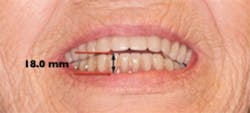Reline Procedure
Revisiting the reline procedure may keep you out of trouble Part 1
by Joseph J. Massad, DDS
Welcome back! This month’s tip involves revisiting the reline procedure for both removable prosthodontics and implant over-denture procedures. Dentists frequently complain of problems with laboratory relines. How can we avoid some of the pitfalls we encounter when sending impressions to labs and receiving unacceptable results for our patients?
We will begin by discussing the most common reline complications reported by dentists, technicians, and patients. This information has been compiled over the last 10 years from my personal interviews with dentists, patients, and prosthetic technicians. I have compiled the complaints into six areas.
- The reline resulted in less stability and retention.
- The patient accused the dentist of moving the midline.
- The patient said more gum showed after the reline was delivered.
- The patient said they could not chew as well after the dentist delivered the reline.
- The dentist blamed the lab and reluctantly refunded the patient’s money.
- The technician told the dentist that the prosthesis fit the model.
In the first of this two-part series, I would like to address the reasons why these problems exist. In Part 2, I will provide a step-by-step procedure and a protocol which should eliminate the six complaints listed above.
FIG. 1
In general, dentists and technicians have felt that edentulous patients are just unhappy since they’ve lost their teeth, and they blame everyone but themselves. However, from what we know today in dentistry, these patient complaints are valid and can be addressed to a successful conclusion.
It is a known fact that esthetics, stability, and retention may adversely be affected if an increase in the patient’s existing occlusal vertical dimension exceeds 2 mm or more of thickening of the denture base. As seen in Figure 1, this patient had a mandibular reline performed, and at its completion, the patient’s occlusal plane was increased beyond functional capacity. The incisal edges of the mandibular prosthesis in relationship to the lower lip measured 18 mm. This, of course, resulted in instability due to the fact that the tongue, when in function, virtually pushed the denture outside of the mouth. The occlusal plane is superior to all referenced dental concepts.
This patient’s reline created an opening of her existing vertical, which in turn created instability, loss of retention, an altered esthetic midline, and an unnatural, gummy appearance. The dentist refunded her money while blaming the lab, and the technician told the dentist that everything fit the model.
So what happened? In consultation with the patient’s dentist to defuse the negative emotions between the two, I discovered that the patient was in a hurry to get her denture tightened and did not want to have a new prosthesis fabricated at that time. The dentist, in an effort to help her out, made a reline impression of her lower denture without relieving the tissue side, and he indicated that he had to do a couple of washes to get it right. Are you beginning to see the problem? As expected, the impression was rather thick, and the resultant reline had a thickened base, thereby creating all six of the complaints listed in this article.
Even when patients present with a severely closed vertical, it is necessary for the dentist to inform them that they will need a new prosthesis instead of having the denture relined. However, we know that in difficult economic situations, many patients will opt to patch their prostheses or have them relined instead of remade. In these cases, it is our responsibility to inform the patient that changes in vertical increase should not be done with a reline since all of the aforementioned problems may occur. Opening the lost vertical should be done with new denture teeth, and not thickening of the denture base.
Offering your patient an occlusal splint as an intermediary fix along with a reline is a much better service than a reline alone, or it may be best to delay treatment. Fully informed patients are less critical and generally will appreciate your professional honesty. In Part 2, I will outline a documented method that has been extremely successful, which you may want to consider to avoid distasteful situations such as this.
I hope this tip has helped you. Again, I hope my pleasure in dentistry will also be yours.
See you next month.
Dr. Joseph Massad may be reached by phone at (918) 749-5600 or by email at [email protected].
To see Dr. Massad’s video tips, visit www.DentalLibrary.com
Past DE Issues

